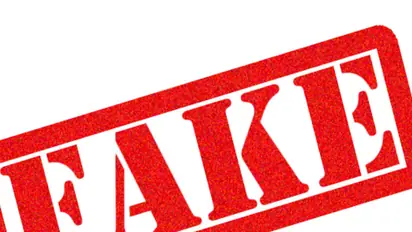Fake news in India on the rise: Here's how to tackle it

Synopsis
No, our Rs 2000 note isn't declared the best currency and neither is our National Anthem. It's fake. Death of celebs, surfacing of mermaids, charging of iPhones with onions/lemons or alien appearances (like always) are some of the staple fake news and should be taken with a pinch of salt. Yes, fake news 'exists' and you need to stay away from such false stories.
There are several new-age problems, and one of the biggest ones is 'fake news'. If news travels fast, then fake news travels faster! There's always the 'UNESCO declares ‘Jana Gana Mana’ best national anthem' or it declares Rs 2000 currency the best in the world, and so on. All these are nothing but 'fake'.
While fake news has always been there, it’s the widespread of social media that has now made it worse. Sharing a story from an 'unverified' source can be quite disastrous. Imagine this - a fake story appears on your page. You share it without verifying facts, and so do 10 others and the cycle continues. The news creates unwanted ruckus for something that doesn't stand true. That's the power of fake news.
Fake news is no different from an online fraud that leaves you felt cheated. It is getting more difficult to discern the truth with the explosion of news on social media. Is it bad reporting or planned strategy that gives birth to fake news? Here is how to deal with it?
Fake news has been on the rise in India. The more recent, actor PareshRawal’s tweet "Instead of tying stone pelter on the army jeep tie Arundhati Roy!", show that anybody can be a victim of it. Rawal based his tweet on a controversial statement from Roy to Pakistani newspaper, which actually never happened. The statement was published on ‘The Nationalist’ Facebook page.
Chinese smartphone maker Xiaomi also found itself in the middle of a storm when a YouTuber published a video showing its phone catching fire. The video went viral and managed more than 2.4 lakh views within a short span of time, almost 240 times the average viewership of the channel. It was an old CCTV footage of some phone catching fire.
What makes it spread like fire in India?
It is usually difficult to notice fake news before the channel running it or the person involved themselves clarifies. Many new channels on Facebook and YouTube gather viewership with such content. Death of celebs, surfacing of mermaids, charging of iPhones with onions/lemons or alien appearances (like always) are some of the staple fake news and should be taken with a pinch of salt.
The content of such videos or articles is surprising enough to make you click on it and watch/read it till the end. At other times, it is misinformation, spread unknowingly by social media channels that have become mainstream for news consumption.
But in India, analysts say Whatsapp is a bigger circle for a first round of push. Anything circulating on Whatsapp that gains momentum is picked up by Facebook pages. They are off course unverified, but the viral nature of the content would get instant hits and numbers for the page, a strategy followed by most.
How to avoid fake news
Unless something is officially declared, you will find a disclaimer, and if you don’t, there are chances the story is a traffic gathering click-bait that is probably made-up. Always take speculations, ‘shocking’ or ‘surprising’ videos and ‘this will change your life’ kind of stuff with a grain of salt.
More importantly you should know the authenticity of the source the news is based on. If there is a tweet you are looking at, there should be a verified sign from Twitter that confirms the identity of the person. Don’t look at number of followers. Mukesh Ambani’s account has 28k followers, but it is still a fake account.
You may not believe every post that you see on Facebook, especially news stories, unless it is from a trusted publication. Or share it just yet without confirming its authenticity.
Facebook, early this year revealed that it has made an algorithm by analysing pages that push fake news that will try and detect such content automatically and push it down in feed. There are browser extensions like B.S. Detector and Fake News Alert that use algorithms to detect fake news. But it won’t be able to detect all stories or some stories it may wrongly detect.
It makes sense to be a little sceptical at almost everything you see on social media these days. We are not yet in the era when bots are making news. Imagine a time when software could automatically create fake video footage using tons of data available online or mimic the voice of public figures using their sound signature. You will have no reason not to believe. Take a look at how researchers were able to create a fake video starring Obama, without him.
Find the latest Technology News covering Smartphone Updates, AI (Artificial Intelligence) breakthroughs, and innovations in space exploration. Stay updated on gadgets, apps, and digital trends with expert reviews, product comparisons, and tech insights. Download the Asianet News Official App from the Android Play Store and iPhone App Store for everything shaping the future of technology.